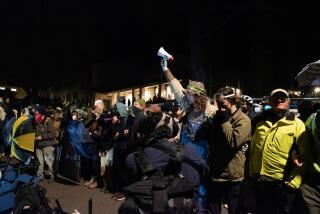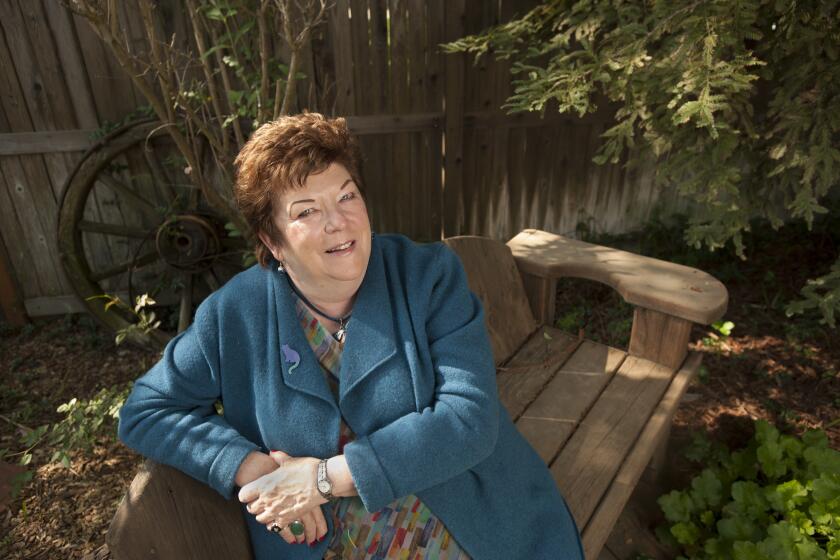False Alarms : A Big Pain in the Ear for Police
Wolf! Wolf! Wolf!
That’s what members of San Diego’s police force hear, on average, more than 80 times a day from their dispatchers. Then off they go, responding to yet another of the false burglar-alarm reports they receive 2,500 times a month, knowing that just one in 25 is for real.
“It concerns us tremendously, the cry-wolf syndrome,” said Sgt. Stan Elmore, who is in charge of police licensing for the city’s 18,000 residential and commercial alarms. “Officers can get careless about responding. It’s part of human nature.”
What’s more, the problem is growing along with San Diego’s burgeoning population: Each month, the Police Department grants permits for 300 to 400 new alarms. Given the 15 to 20 minutes that Elmore estimated police spend on each response, false alarms cost the city untold hours of patrol power and about $30,000 a month in police salaries.
Search for Solutions
Concern about the alarms--which are most commonly triggered by humans but can also be set off by power outages and earthquakes--has prompted the department to initiate a search for ways to better manage the automatic alert system.
“We’re going to be looking at the problem over the next few months,” Elmore said. “We could stop responding. . . . That’s an option.”
Other alternatives include charging a business or homeowner a fee each time officers respond to a false alarm, an approach used by Poway and other municipalities, Elmore said.
The only current check on false alarms is a 1981 San Diego Municipal Code provision that suspends alarm permits for two false reports within 30 days, three false alarms in 90 days, and so on.
Permits can be reissued for a $25 fee after the first revocation, $50 after the second revocation within two years, and so on on a sliding scale up to $200. All told, the city recoups about $1,500 to $2,000 of its losses through fines each month, Elmore said.
One repeat victim of the fines is La Jolla Gallery Studio, a photography studio on La Jolla Boulevard. Owner Bob Stickel reported 20 false alarms over the last year and a half, a record that cost him $175. He attributes his troubles to the 27 photographers who share the studio and are careless with the burglar alarm system.
“Three people were responsible for all but a few of them,” Stickel said. “Two of the people have had their access yanked, and one will (have) if he does it again. Some people don’t deal with electronics and gadgetry well.”
Unnecessary Police Calls
Stickel added that police are sometimes unnecessarily summoned because the alarm company that services his studio fails to contact him before notifying officers, particularly when the signal sounds late at night.
Most alarms in San Diego County--whether triggered by motion, sound or other sensors--automatically notify an alarm company, which may or may not check with the owner before calling police or another number.
While Elmore would not say whether human or mechanical error bears more of the blame for false alarms, executives at two local burglar alarm companies said the consumer is at fault more often than not.
Carl A. Smith, vice president of San Diego Alarm Co., said the customer blunders about 70% of the time; Robert Berlin, president of Morse Signal Devices, put the figure at 50% to 60%.
Elmore said other triggers include phone line problems, power outages, wind, earthquakes and even sonic booms.
Both Smith and Berlin said they are well aware of the headaches false alarms give police. The problem is an irritant for them as well, they said, because both fines and slowed police response times decrease customer satisfaction.
To help stem the tide of misfires, Berlin said, his employees are giving sterner lectures to customers about precautions they should take. Smith said his firm has stepped up repair service and contacts property owners more frequently to double-check alarm signals. Also, San Diego police have begun checking with the company or home whose alarm is sounding before they respond.
Policies Vary Widely
Elsewhere in the county, false-alarm policies vary widely.
In unincorporated areas and in cities that contract for Sheriff’s Department protection, regulations covering burlgar alarms are far less strict. The county has required permits since 1980, but they are valid for an indefinite period, said Jean Snyder, head of the county Licensing Department.
Moreover, it takes five false alarms in a single month to trigger a fine by the county, she said. Despite 16,270 false alarms during the last fiscal year--and as few as 400 legitimate alarms--only 54 citations have been issued by the county since 1980.
But because the number of false alarms is soaring in county-patrolled areas as well--jumping 20% last year alone--Snyder said officials are considering imposing fees for each nuisance alarm that requires a deputy’s response, a system that is employed in Poway.
Th current “ordinance is just not working,” she said. “It’s costing the county an arm and a leg.”
Oceanside has no permits or restrictions. Escondido, where the number of false alarms has risen from 220 a month last year to more than 300 a month in 1988, allows only one false alarm in a year before assessing the owner a $25 fine. The third misstep costs $50, and after the fourth the city requires a written explanation of the problem and the steps undertaken to correct it, said police Sgt. Mark Martin, supervisor of the crime prevention unit.
The fifth false alarm in a year prompts a one-month suspension of the alarm permit, followed by a 90-day suspension if a false alarm again occurs. So far it hasn’t come to that for anyone, Martin said.
Nationwide, the first false alarm ordinances appear to have been passed in 1972 by the cities of Pasadena, Calif., and Lower Merion Township, Pa., said Anne Lobel Armel, editor of Security Distributing & Marketing magazine.
A survey of ordinances, conducted by the magazine in 1987, found that one-fourth to one-third of the cities polled had adopted policies of not responding to homes and businesses with a history of false alarms. Most of the rest imposed fines for false alarms.
The survey also found that two cities--Tucson, Ariz., and Southfield, Mich.--have established priority for police response based on the number of previous false alarms from the address calling for help.
In several of the cities with stricter regulations, police officials said statistics show a gradual but significant decrease in the number of false alarms.
More to Read
Start your day right
Sign up for Essential California for news, features and recommendations from the L.A. Times and beyond in your inbox six days a week.
You may occasionally receive promotional content from the Los Angeles Times.






